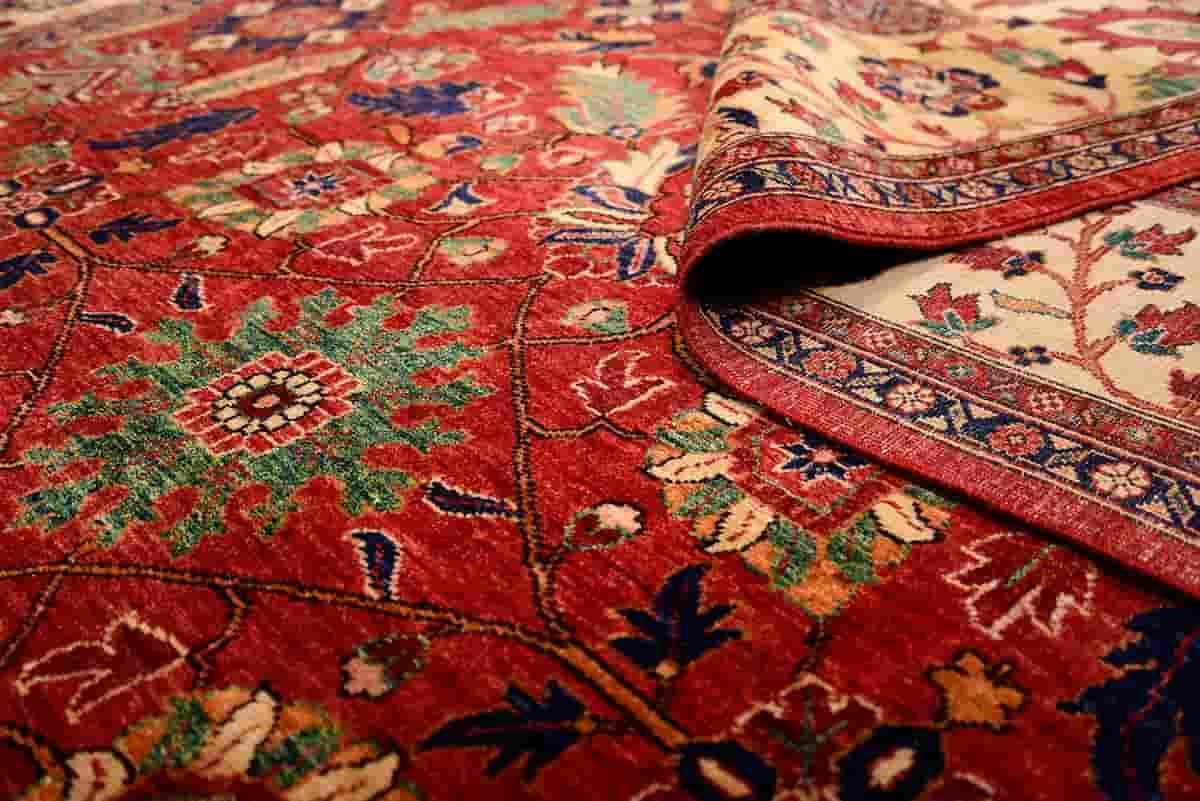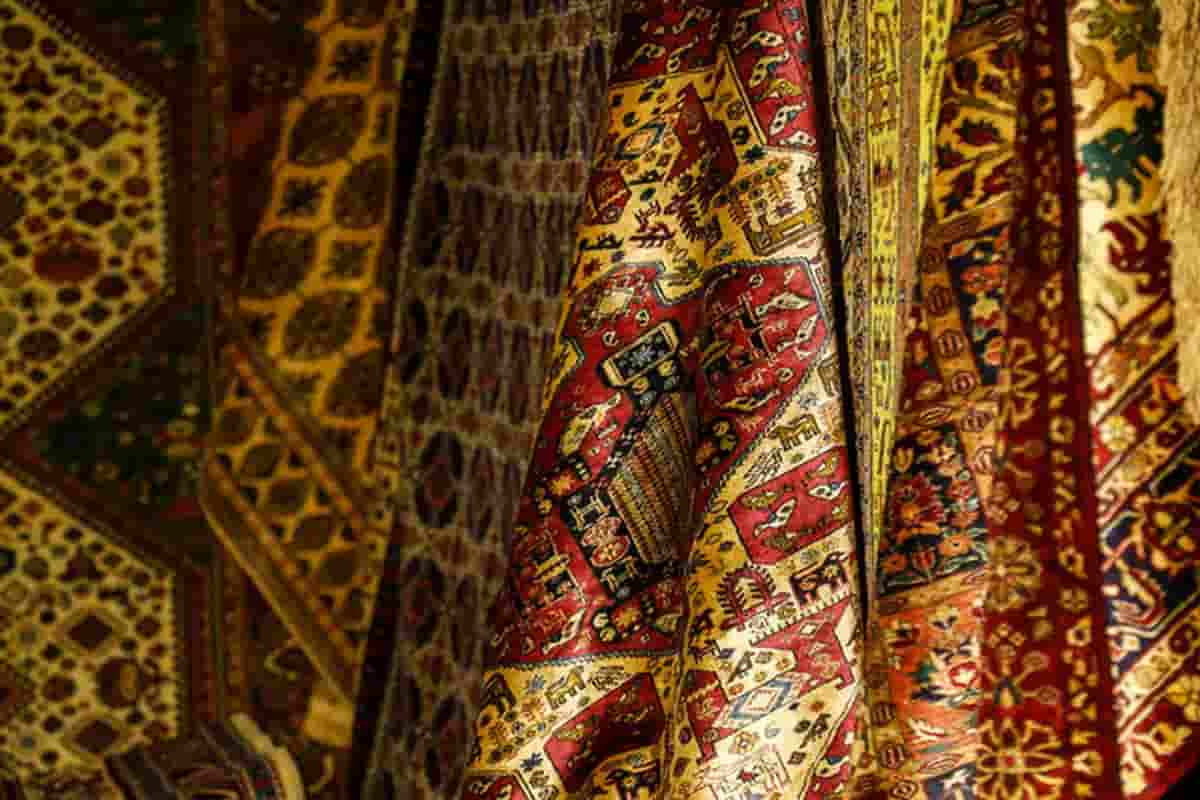There are many types of materials used in Persian carpets like wool, cotton, silk, polyester, and acrylic and the most recent material is heat-set acrylic.
Persian carpet materials
The materials used in carpet weaving vary and include natural wool, in some cases even silk, polypropylene, polyester, and acrylic. As wool is very expensive, this natural material is usually used in handmade carpets and occasionally used in machine-woven carpets or obsolete completely. One of the important characteristics and advantages of woolen carpets is that the carpets are cold in summer and warm and comfortable in winter. The main disadvantage of woolen carpets is that dust is difficult to remove from their surfaces, and cleaning and washing them is difficult. Another important thread that is used mostly in machine-woven carpets is acrylic which replaced wool due to its reasonable price. Besides the advantage of a lower price, this type of thread has some drawbacks like high yield, fiber fragility, difficulty in washing, and potential for developing or exacerbating sensitivity, so its use is not advised. In order to address these issues, the most modern type of acrylic manufactured and employed by major carpet manufacturers is known as heat-set acrylic. This thread has several advantages, and it is used to weave high-quality carpets, particularly 1200-reeds, 1500-reeds, and 1600 or, more recently, 1700-reed machine-woven carpets. Polyester or artificial silk fibers is another type of fabric that has seen a lot of use in the creation of machine-made carpets in recent years. Because of their integrated structure - similar to silk threads - these fibers are lint-free and hypoallergenic, and the carpets made with them are very easy to wash and have excellent color stability and sheen. Acrylic fibers are losing their prominence in the textile business, according to Fiber Year magazine. Acrylic fiber output climbed by 1.9%, while polyester fiber production increased by 7.6%. Polyester fibers have grown at an average rate of 8.6% over the last seven years. Polypropylenes are another type of fiber that, over time, get discolored, knotted, and crushed, destroying the softness of the carpet. To sum up, the number of firms and manufacturers producing carpets with polyester filament fibers and heat-set acrylic is growing day by day. 
What are Persian carpets made of
Machine-made carpets on the carpet market are woven from various yarns and these threads are classified into two categories. Natural carpet fibers: These fibers are the best form of carpet thread and are primarily utilized in handwoven carpets. Natural carpet threads are also classified into two types: vegetable fibers like cotton and jute and animal fibers like wool and silk. Synthetic fibers: These threads are not natural, as the name implies, they are created by petroleum and humans. Acrylic, nylon, polyester, and polypropylene are examples of artificial fibers used in carpets. In general, three types of threads are utilized in the manufacture of machine-made carpets: Pile yarn: Pile yarn (in Persia Khab) is the yarn that covers the full surface of the carpet and must have properties such as excellent wear resistance and reversibility. Warp Yarn: warp thread (in Persia Chele thread) is a component of carpet that provides strength and resistance along the direction of the carpet's length and is typically constructed of fibers such as cotton, polyester, or a combination of the two. Weft Yarn: The weft thread is the same as the carpet thread holder and strengthens the carpet in the transverse direction. Cotton, jute, and polyester are common weft thread materials for Persian carpets, especially machine-made carpets. 
Persian rugs are made of
When purchasing a machine-woven carpet, most people come across terms like ‘100% acrylic heat set’ or ‘the word heat set’, and they want to know what heat set thread is in a machine carpet, what it is used for, and how important it is. The definition of heat-set acrylic yarn and its benefits and advantages will be discussed in the following content. Heat set, or heat set machine in the spinning machines, is one of the characteristics of the yarns used in machine carpet weaving, during which the inner texture of the carpet fibers is spun and stabilized by heat and steam using the heat set machine. As a result, the heat-set yarn has unique qualities and is the same, making it particularly beneficial for carpet weaving machines. Nowadays, the majority of machine-made carpets available in carpet stores, especially more recent and quality 1200-reed and 1500-reed carpets are made of heat-set acrylic. These carpets not only have a higher quality than other carpets but also have features such as very high resistance to dust, light, and heat, pliability and high pressure, and high reversibility. Acrylic carpets, for instance, can withstand a hot iron or pot for 5 minutes without any damage. One of the most significant benefits of acrylic carpets is that the acrylic thread becomes lint-free during the heat-setting process, therefore acrylic back carpets are referred to as lint-free carpets (anti-allergenic carpets).  According to the information provided above, the best and highest quality machine-made carpets on the market are acrylic-woven carpets. We should compare heat-set acrylic carpets to polyester and non-acrylic carpets to gain a better understanding of them. 1- Acrylic fibers have distinct threads and pomegranate seeds, which may be observed with careful inspection. 2- Acrylic fibers are resistant to light and heat and can tolerate a hot iron for 5 minutes without being damaged. 3- This thread has strong reversibility (resistance of the carpet against being worn). 4- Polyester carpets are less expensive than acrylic carpets. 5- If we touch the carpet's surface, the threads should slide under our hands. The final note regarding is that in carpet weaving, two types of thread and fibers are used: staple and continuous (BCF), which stands for Bulk Continuous Filament, and the difference between these two fibers is their length. Partial fibers are woven together in 7–25 cm portions to make machine carpet thread, while BCF yarns are weaved indefinitely.
According to the information provided above, the best and highest quality machine-made carpets on the market are acrylic-woven carpets. We should compare heat-set acrylic carpets to polyester and non-acrylic carpets to gain a better understanding of them. 1- Acrylic fibers have distinct threads and pomegranate seeds, which may be observed with careful inspection. 2- Acrylic fibers are resistant to light and heat and can tolerate a hot iron for 5 minutes without being damaged. 3- This thread has strong reversibility (resistance of the carpet against being worn). 4- Polyester carpets are less expensive than acrylic carpets. 5- If we touch the carpet's surface, the threads should slide under our hands. The final note regarding is that in carpet weaving, two types of thread and fibers are used: staple and continuous (BCF), which stands for Bulk Continuous Filament, and the difference between these two fibers is their length. Partial fibers are woven together in 7–25 cm portions to make machine carpet thread, while BCF yarns are weaved indefinitely. 
